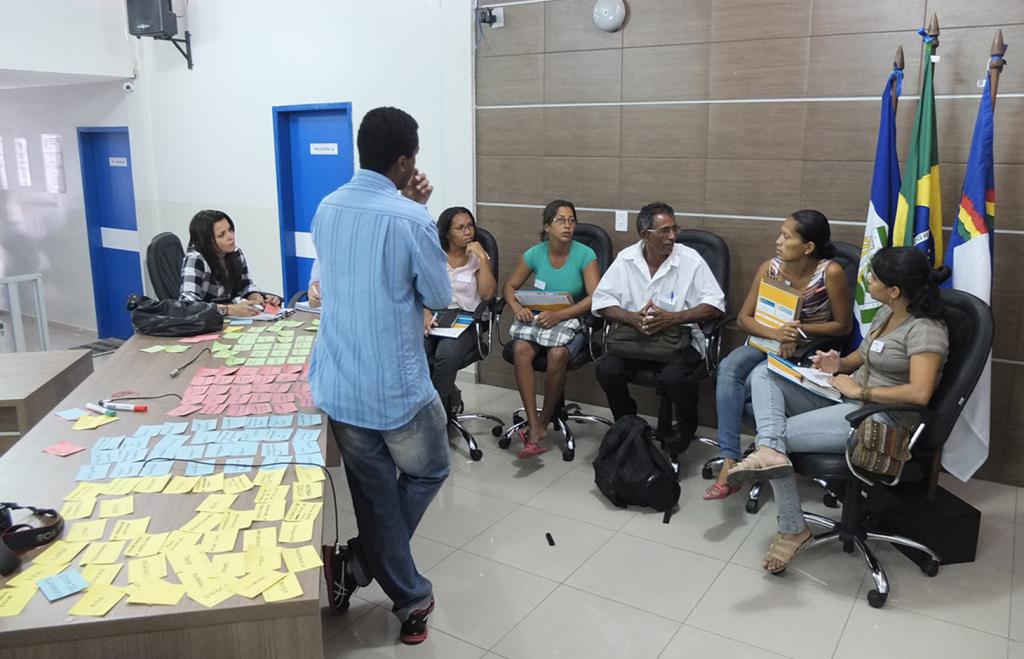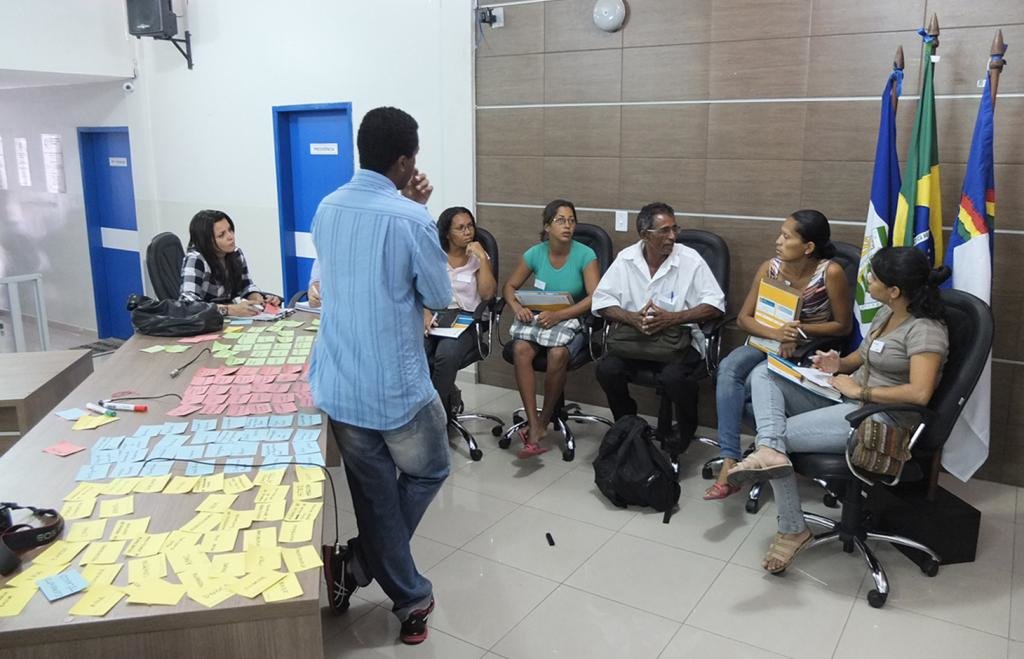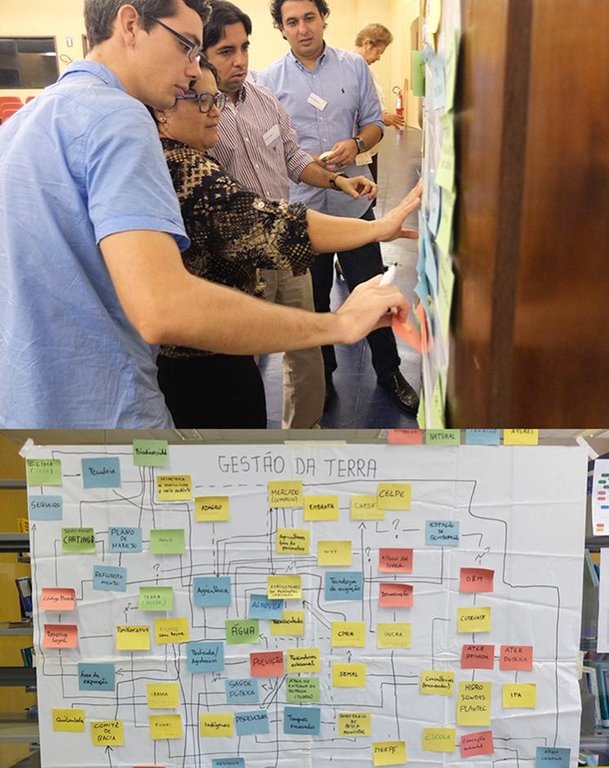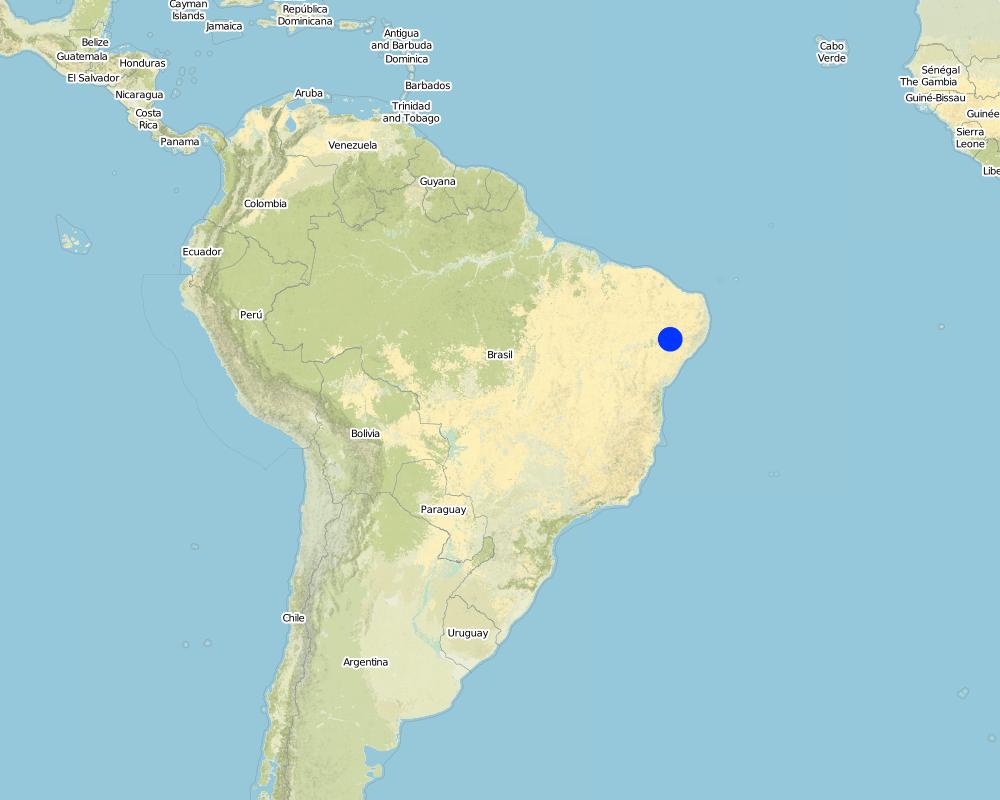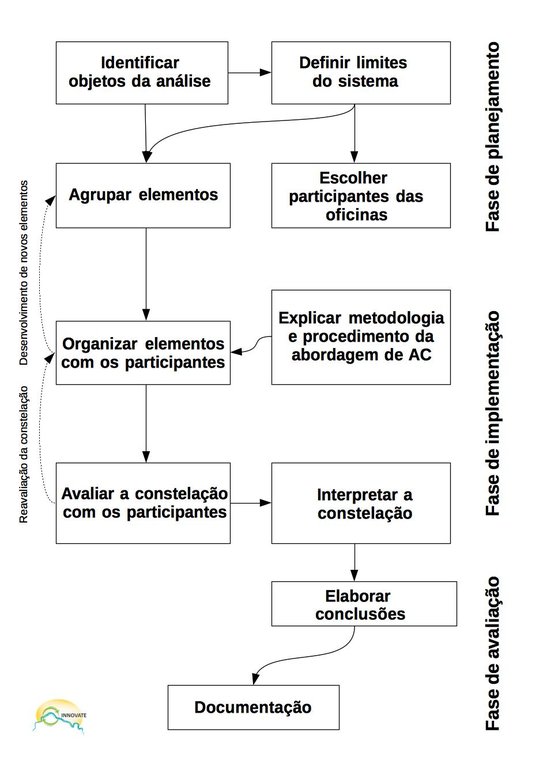Constellation Analysis [บราซิล]
- ผู้สร้างสรรค์:
- การอัพเดท:
- ผู้รวบรวม: Verena Rodorff
- ผู้เรียบเรียง: –
- ผู้ตรวจสอบ: Deborah Niggli
Análise de Constelação
approaches_1974 - บราซิล
ดูส่วนย่อย
ขยายทั้งหมด ย่อทั้งหมด1. ข้อมูลทั่วไป
1.2 รายละเอียดที่ติดต่อได้ของผู้รวบรวมและองค์กรที่เกี่ยวข้องในการประเมินและการจัดเตรียมทำเอกสารของแนวทาง
ผู้เชี่ยวชาญ SLM:
ชื่อของโครงการซึ่งอำนวยความสะดวกในการทำเอกสารหรือการประเมินแนวทาง (ถ้าเกี่ยวข้อง)
Book project: Making sense of research for sustainable land management (GLUES)1.3 เงื่อนไขที่เกี่ยวข้องกับการใช้ข้อมูลที่ได้บันทึกไว้ผ่านทาง WOCAT
วันที่เก็บรวบรวมข้อมูล (ภาคสนาม):
23/06/2015
ผู้รวบรวมและวิทยากรหลักยอมรับเงื่อนไขเกี่ยวกับการใช้ข้อมูลที่ถูกบันทึกผ่านทาง WOCAT:
ใช่
2. คำอธิบายของแนวทาง SLM
2.1 การอธิบายแบบสั้น ๆ ของแนวทาง
Constellation Analysis is a tool used to clarify perceptions of different stakeholders about critical situations or problems. In workshops, participants visualize interrelationships between actors, as well as the associated natural, technical and regulatory factors.
2.2 การอธิบายอย่างละเอียดของแนวทาง
การอธิบายอย่างละเอียดของแนวทาง:
The Constellation Analysis method (CA) aims at a transparent, mutually accepted visualization of factors (‘elements’) that are systematically arranged under the method's four categories: actors; rules and concepts; natural elements; technical elements, with the type of their inter-relationships. The process enables consensus to be found between divergent positions, paving the way for better informed decision-making while facilitating a negotiated process of land management with potential changes/techniques.
During brainstorming and/or literature-based approach, different elements are determined and arranged visually on a board. Element categories are actors (e.g. farmers, energy supply company), rules and concepts (e.g. legal framework, plans and programs, regulations), natural factors (e.g. climate, vegetation, water) and technical factors (e.g. fertilizer, wastewater treatment, hydropower plant). Usually this is done by using differently coloured and shaped cards to help articulate ideas within a working group. Then, connections among and between the elements are discussed and the form of these interrelations are visualized as being (a) directed, (b) conflictive, (c) non-existent, (d) contradictory, (e) reluctant or (f) interactive. Through this approach the way towards developing solutions (or follow-up CAs) is guided.
The approach was applied at different scales and with different stakeholders with divergent professional expertise and educational levels, e.g. farmers, fishermen, employees of the government, representatives of indigenous tribes, associations, trade unions, and researchers. People found the methodology promising as it raises awareness and organizes information. Training in the methodology has been carried out amongst interested people at two universities, but not yet local development agents.
The visualization is carried out through an iterative group process. A moderator is needed to initiate the process by inviting the different stakeholders to a conducive location, and to facilitate the process. Exchange among participants is enhanced, and this leads to better understanding of different viewpoints in situations of tension or in the understanding of what has evolved through specific developments in the past. During a second analytical step, the main lessons of the visualization are extracted and documented. Here, missing factors/relationships, and consequently the need for action, are detected. For example, insufficient communication between actors could be uncovered, or it may be detected that planning programs need to be improved.
2.3 รูปภาพของแนวทาง
2.5 ประเทศ ภูมิภาค หรือสถานที่ตั้งที่ได้นำแนวทางไปใช้
ประเทศ:
บราซิล
ภูมิภาค/รัฐ/จังหวัด: :
Pernambuco, Brazil
ข้อมูลเฉพาะเพิ่มเติมของสถานที่ตั้ง:
Itaparica Reservoir, Petrolândia
Map
×2.6 วันที่เริ่มต้นและสิ้นสุดของแนวทาง
ระบุปีที่เริ่ม:
2012
การสิ้นสุดลง (ถ้าแนวทางไม่ได้ใช้อีกต่อไป):
2016
2.7 ประเภทของแนวทาง
- ใช้โครงงานหรือแผนงานเป็นฐาน
2.8 เป้าหมายหรือวัตถุประสงค์หลักของแนวทาง
The approach can be applied at different levels and for different issues or contexts: all perspectives can be represented and discussed. The application in this case was devised to be an iterative process of consecutive workshops first at the local irrigation project level, and then at the municipal, regional and national levels with the aim of analysing the inhibiting and driving forces behind the current situation in water management, in land management, and around production cycles in agriculture and aquaculture leading to action being taken or decisions made. Farmers and fishermen, employees of government, researchers and experts are considered as the relevant target group to be involved in participatory workshops. In the education sector, the approach can be applied for theses, for field work and for projects as an analytical interdisciplinary approach.
2.9 เงื่อนไขที่เอื้ออำนวยหรือเป็นอุปสรรคต่อการนำเทคโนโลยีภายใต้แนวทางนี้ไปปฏิบัติใช้
บรรทัดฐานและค่านิยมทางสังคม วัฒนธรรม ศาสนา
- เอื้ออำนวย
In some cases, segregation of social or gender groups, especially at the beginning of the exercise, can be helpful. No means has yet been found to reduce ‘mobile phone distraction’ in an acceptable way.
การจัดตั้งระดับองค์กร
- เอื้ออำนวย
Argumentation promoting the value of the process may help to ‘sell’ the approach.
ความรู้เกี่ยวกับ SLM การเข้าถึงการสนับสนุนด้านเทคนิค
- เอื้ออำนวย
It may be possible to organize a pick-up service for participants or to choose an easy-access location.
ปริมาณงานที่ทำได้ กำลังคนที่มีให้
- เอื้ออำนวย
It is important to discuss potential dates in advance. Some people prefer weekends, others don’t. The lunch break is useful for more informal interaction. However others use the break to disappear.
อื่นๆ
- เอื้ออำนวย
The iterative process of the CA promotes a re-assessment of constellations during different group discussions. Views of dominant individuals can be modified in the iterative procedure, especially when participants with different standpoints and positions are involved. The goal is the mutual understanding of divergent positions towards entry points for change or adaptation.
3. การมีส่วนร่วมและบทบาทของผู้มีส่วนได้ส่วนเสียที่เกี่ยวข้อง
3.1 ผู้มีส่วนได้ส่วนเสียที่เกี่ยวข้องในแนวทางนี้และบทบาท
- ผู้ใช้ที่ดินระดับท้องถิ่นหรือชุมชนระดับท้องถิ่น
smallholders of local agricultural community
- ผู้เชี่ยวชาญ SLM หรือที่ปรึกษาการเกษตร
- ครู เด็กนักเรียน หรือนักศึกษา
students only in observing role
- รัฐบาลแห่งชาติ (ผู้วางแผน ผู้ทำการตัดสินใจ)
3.2 การเกี่ยวข้องของผู้ใช้ที่ดินระดับท้องถิ่นหรือชุมชนระดับท้องถิ่นในช่วงต่างๆของแนวทาง
| ความเกี่ยวข้องของผู้ใช้ที่ดินระดับท้องถิ่นหรือชุมชนระดับท้องถิ่น | ระบุผู้ที่มีส่วนเกี่ยวข้องและอธิบายกิจกรรม | |
|---|---|---|
| การริเริ่มหรือการจูงใจ | ไม่ลงมือ | Interviews |
| การวางแผน | ไม่มี | |
| การดำเนินการ | ปฏิสัมพันธ์ | Workshops |
| การติดตามตรวจสอบหรือการประเมินผล | ปฏิสัมพันธ์ | Workshops |
| research | ปฏิสัมพันธ์ | Data analysis, lessons learnt, etc |
3.3 แผนผังแสดงขั้นตอนการทำงาน (ถ้ามี)
คำอธิบาย:
Simplified flowchart of the Constellation Analysis Approach.
Planning phase:
Clarify the objective or question behind the analysis. Then, have an overview research about first elements (assembling elements), e.g. which actors can give interesting input and how to contact them. Preparing material for the workshop(s): coloured cards, pens, whiteboard, etc.
Implementation phase:
Explain the objective and methodology to participants, the meaning of the elements: actors; rules and concepts; natural elements; technical elements and their different relations. Clarify rules of respecting each other. Arrange the elements. Evaluate the constellation together with participants, e.g. why are elements far or close to each other? Why are relations conflictive and how to overcome? Are elements or relations missing? Is all information available? What are the next step? Can recommendations be formulated?
Evaluation phase:
Were participants objective enough? How to interpret participant’s activity within the workshop? Which actors should be asked as well? Consolidate participants’ statements with literature and research and document. Documentation could be a photo or digitalized picture of results with an explanation based on literature.
ผู้เขียน:
Liron Steinmetz
3.4 การตัดสินใจเลือกใช้เทคโนโลยี SLM
ระบุผู้ที่ทำการตัดสินใจเลือกเทคโนโลยีมากกว่าหนึ่งวิธีไปปฏิบัติใช้:
- ผู้ใช้ที่ดินเป็นผู้ตัดสินใจหลัก โดยการสนับสนุนจากผู้เชี่ยวชาญ SLM
การอธิบาย:
Constellation Approach is not linked with a specific technology. Can be used in a planning phase in sustainable land management. Various methods, technologies and management approaches can be derived from the applied Constellation CA Approach, and can be specified depending on the SLM problem.
4. การสนับสนุนด้านเทคนิค การสร้างขีดความสามารถ และการจัดการด้านความรู้
4.1 การสร้างขีดความสามารถ / การอบรม
ได้มีการจัดอบรมให้แก่ผู้ใช้ที่ดินหรือผู้มีส่วนได้ส่วนเสียคนอื่น ๆ หรือไม่:
ใช่
ให้ระบุว่าใครเป็นผู้ได้รับการอบรม:
- ผู้ใช้ที่ดิน
- เจ้าหน้าที่ภาคสนาม / ที่ปรึกษา
รูปแบบการอบรม:
- workshops
หัวข้อที่พูด:
detecting knowledge gaps and clarifying positions of players, and role of natural, technical and regulatory elements from multi-angled viewpoints/perspectives as core of the CA-Approach.
4.2 การบริการให้คำแนะนำ
ผู้ใช้ที่ดินมีการเข้าถึงการรับบริการให้คำปรึกษาหรือไม่:
ใช่
- workshops
4.3 การเสริมความแข็งแกร่งให้กับสถาบัน (การพัฒนาองค์กร)
สถาบันได้รับการจัดตั้งขึ้นมาหรือเสริมความแข็งแกร่งโดยแนวทางนี้หรือไม่:
- ไม่
4.4 การติดตามตรวจสอบและประเมินผล
การติดตามตรวจสอบและประเมินผลเป็นส่วนหนึ่งของแนวทางหรือไม่:
ใช่
ถ้าตอบว่าใช่ แสดงว่าการจัดเตรียมเอกสารนี้มุ่งหวังที่จะเอาไปใช้สำหรับการติดตามตรวจสอบและประเมินผลใช่หรือไม่:
ไม่ใช่
4.5 การวิจัย
การวิจัยเป็นส่วนหนึ่งของแนวทางหรือไม่:
ใช่
ระบุหัวข้อเรื่อง:
- สังคมวิทยา
- เศรษฐศาสตร์หรือการตลาด
- นิเวศวิทยา
- เทคโนโลยี
5. การสนับสนุนด้านการเงินและวัสดุอุปกรณ์
5.1 ระบุงบประมาณประจำปีสำหรับแนวทาง SLM นี้
ถ้าหากว่างบประมาณประจำปีไม่เป็นที่ทราบแน่นอน ให้ระบุช่วงลงไป:
- < 2,000
แสดงความคิดเห็น (แหล่งของการระดมทุน ผู้บริจาคคนสำคัญ):
German Federal Ministry of Education and Research (BMBF) 100%
5.2 การสนับสนุนด้านการเงิน / วัสดุอุปกรณ์ให้แก่ผู้ใช้ที่ดิน
ผู้ใช้ที่ดินได้รับการสนับสนุนด้านการเงิน / วัสดุอุปกรณ์ไปปฏิบัติใช้เทคโนโลยีหรือไม่:
ไม่ใช่
5.3 เงินสนับสนุนสำหรับปัจจัยนำเข้า (รวมถึงแรงงาน)
- ไม่มี
ถ้าแรงงานโดยผู้ใช้ที่ดินเป็นปัจจัยนำเข้าที่มีอยู่มากมาย ระบุด้วยว่าเนื่องจาก:
- สมัครใจ
5.4 เครดิต
มีการจัดหาเครดิตมาให้ภายใต้แนวทาง SLM หรือไม่:
ไม่ใช่
5.5 แรงจูงใจหรือเครื่องมืออื่น ๆ
แรงจูงใจหรือเครื่องมืออื่น ๆ ได้ถูกนำไปใช้ส่งเสริมการใช้เทคโนโลยี SLM หรือไม่:
ไม่ใช่
6. การวิเคราะห์ผลกระทบและการสรุป
6.1 ผลกระทบของแนวทาง
ช่วยให้ผู้ใช้ที่ดินนำเอาเทคโนโลยี SLMไปใช้และบำรุงรักษาสภาพไว้ได้หรือไม่:
- ไม่ใช่
- ใช่ เล็กน้อย
- ใช่ ปานกลาง
- ใช่ อย่างมาก
No immediate impact, however CA-Approach could prospectively contribute to improved sustainable land management and in particular governance.
ทำให้กลุ่มด้อยโอกาสมีอำนาจทางสังคมและเศรษฐกิจหรือไม่:
- ไม่ใช่
- ใช่ เล็กน้อย
- ใช่ ปานกลาง
- ใช่ อย่างมาก
No immediate impact, however CA-Approach could prospectively contribute to an improved situation of socially and economically disadvantaged groups.
Did other land users / projects adopt the Approach?
- ไม่ใช่
- ใช่ เล็กน้อย
- ใช่ ปานกลาง
- ใช่ อย่างมาก
Interest from cooperating universities (UFPE-Universidade Federal de Pernambuco, IFPE-Instituto Federal de Pernambuco).
Did the Approach lead to improved livelihoods / human well-being?
- ไม่ใช่
- ใช่ เล็กน้อย
- ใช่ ปานกลาง
- ใช่ อย่างมาก
No immediate impact, however CA-Approach could prospectively contribute to improved well-being.
6.2 แรงจูงใจหลักของผู้ใช้ที่ดินเพื่อที่จะนำ SLM ไปปฏิบัติใช้
- การผลิตที่เพิ่มขึ้น
- เกียรติภูมิ แรงกดดันทางสังคม ความเชื่อมแน่นทางสังคม
- การเข้าร่วมสมทบในขบวนการ โครงการ กลุ่ม เครือข่าย
- จิตสำนึกด้านสิ่งแวดล้อม
6.3 ความยั่งยืนของกิจกรรมของแนวทาง
ผู้ใช้ที่ดินสามารถทำให้สิ่งต่างๆ ที่ได้ปฏิบัติใช้โดยแนวทางนี้ยั่งยืนได้หรือไม่ (โดยไม่มีการสนับสนุนจากภายนอก):
- ใช่
ถ้าตอบว่าใช่ ให้อธิบายว่าอย่างไร :
Attained knowledge on a complex, perhaps previously nontransparent system and established contacts support future decision making. In general CA is a flexible method that can be applied by any group, preferentially mixed stakeholder groups.
6.4 จุดแข็งและข้อได้เปรียบของแนวทาง
| จุดแข็ง / ข้อได้เปรียบของแนวทางในทัศนคติของผู้ใช้ที่ดิน |
|---|
| Results can be used for the planning of regional development. |
| Space for interchange of ideas and establishing contacts. |
| Integrates different views of problems. |
| Facilitates participation possibilites for stakeholders. |
| จุดแข็ง / ข้อได้เปรียบของแนวทางในทัศนคติของผู้รวบรวมหรือวิทยากรหลัก |
|---|
| Allows expression and discussion of different views, knowledge integration, both inter- and transdisciplinary, characterised by an iterative and participative nature, able to detect complex situations and questions. |
6.5 จุดอ่อน / ข้อเสียเปรียบของแนวทางและวิธีในการแก้ไข
| จุดอ่อน / ข้อเสียเปรียบในทัศนคติของผู้ใช้ที่ดิน | สามารถแก้ไขปัญหาได้อย่างไร |
|---|---|
| Insufficient space for all to participate, topics covered in too little time. As more than one workshop is needed, the approach does not necessarily provide solutions in the end. | Prepare goal-orientated workshops and finish a workshop by identifying potential solutions and formulating recommendations. I is important to well document and report on the workshops and distribute the reports to stakeholders. |
| จุดอ่อน / ข้อเสียเปรียบในทัศนคติของผู้รวบรวมหรือวิทยากรหลัก | สามารถแก้ไขปัญหาได้อย่างไร |
|---|---|
| One workshop cannot manage to convey the dynamics of a situation. | Formulate recommendations for action and distribute a report to stakeholders. |
| CA only visualizes the current situation. Different future scenarios over a given timespan can be presented only in a series of single CA visualizations. | CA could lay the groundwork for scenario modelling approaches (e.g. Bayesian Networks). |
| One workshop cannot manage to convey the dynamics of a situation. | Formulate recommendations for action and distribute a report to stakeholders. |
7. การอ้างอิงและการเชื่อมต่อ
7.1 วิธีการหรือแหล่งข้อมูล
- ไปเยี่ยมชมภาคสนาม การสำรวจพื้นที่ภาคสนาม
- การสัมภาษณ์กับผู้ใช้ที่ดิน
7.2 การอ้างอิงถึงสิ่งตีพิมพ์
ชื่อเรื่อง ผู้เขียน ปี ISBN:
): Rodorff V.et al. (2013a) Driving forces and barriers for a sustainable management of the Itaparica reservoir region - basic milestones towards a constellation analysis.
ช่องทางในการสืบค้น และราคา:
Gunkel G. et al. (Eds.) (2013) Sustainable Management of Water and Land in Semiarid Areas. Editora Universitária UFPE, Recife, pp 2
ชื่อเรื่อง ผู้เขียน ปี ISBN:
Rodorff, V., Siegmund-Schultze, M., Köppel, J., Gomes, E.T.A. (2015) Governança da bacia hidrográfica do rio São Francisco: Desafios de escala sob olhares inter e transdisciplinares.
ช่องทางในการสืบค้น และราคา:
Revista Brasileira de Ciências Ambientais 36, 30-56.
ลิงก์และโมดูล
ขยายทั้งหมด ย่อทั้งหมดลิงก์
ไม่มีลิงก์
โมดูล
ไม่มีโมดูล


